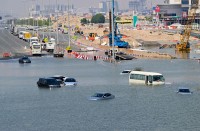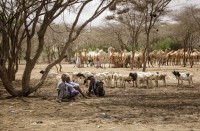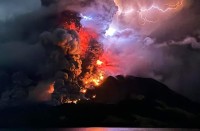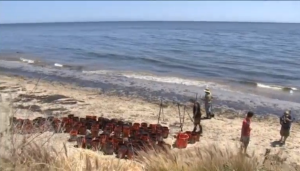
MAY 21 (Reuters) — Cleanup crews fanned out on Wednesday (May 20) across an oil-fouled California beach to scoop up gobs of petroleum spewed from a ruptured pipeline in the largest oil spill to hit the pristine but energy-rich Santa Barbara coastline in nearly two decades.
The breach was believed to have spilled up to 2,500 barrels (105,000 gallons) of crude petroleum, five times more than initially estimated after Tuesday’s rupture, the pipeline company said in an update posted online on Wednesday.
By Wednesday, a 4-mile (6-km) stretch of beach was blackened, and an oil slick spanned more than 9 miles (14 km) of the ocean.
Crews were focusing on three especially sensitive sites known as nesting areas for shore birds, including snowy plovers and least terns.
“We arrived today, there was one gentleman on the beach shoveling oil from the ocean into the buckets and we decided to join him and the next thing you know a lot more of us came down here. It was really very in the morning, about 7 a.m. and so we’ve been shoveling buckets ever since,” said Osiris Castaneda, a resident of nearby Carpinteria.
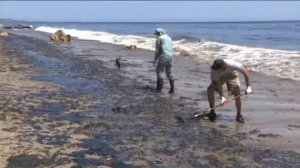
Refugio State Beach and adjacent campgrounds were to remain closed to the public through the Memorial Day holiday weekend, officials said. The area was also closed to fishing and shellfish harvesting.
At daybreak, about 130 cleanup workers contracted by Plains were on beach scooping up globs of oil from the sand, raking up tar balls and disposing of the material in plastic bags.
It marked the biggest oil spill in the region since an offshore rupture in 1997 that dumped up to 1,000 barrels of crude into the Santa Barbara Channel, about 125 miles (200 km) northwest of Los Angeles.
That spill, and Tuesday’s accident, pale in comparison with the estimated 80,000 to 100,000 barrels of oil that gushed into the channel from an offshore oil-well blowout in 1969 and still ranks as the largest oil spill ever in California waters.
“I have seen it on film, in 1969 there was an oil spill in Santa Barbara,” said Castaneda. “They launched the modern day environmental movement, it created Earth Day. So, Earth Day was created by the oil spill in 1969 in Santa Barbara. I guess we haven’t learned the lesson. When you look off our coast you’ll see a lot of oil rigs, we don’t want oil rigs off our coastline. Period.”
Back on Wednesday, wildlife teams were dispatched to the scene to rescue any sea birds, marine mammals and other animals injured by the spill, but authorities said the extent of damage to wildlife was not immediately known.
Crews will also scrub soiled rocks, hose down contaminated areas and skim up oil left behind.
Nine cleanup vessels plied the ocean, six of them corralling the slick with booms and three others skimming up oil from the surface. By about 8:30 a.m., crews had managed to recover about 120 barrels of spilled crude, most of that from the beach, officials said.
The pipeline that burst on Tuesday typically carries about 1,200 barrels of oil an hour from Exxon Mobil’s Las Flores Canyon processing facility to a distribution hub in Bakersfield hundreds of miles away, company and county officials said.
The company said an internal inspection of the pipeline was conducted a few weeks ago but results had not yet come back.

